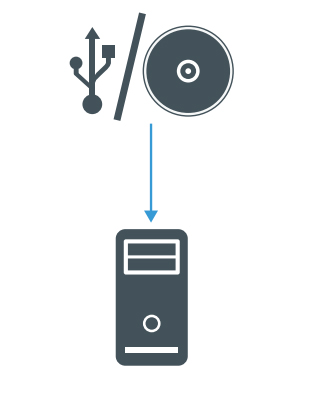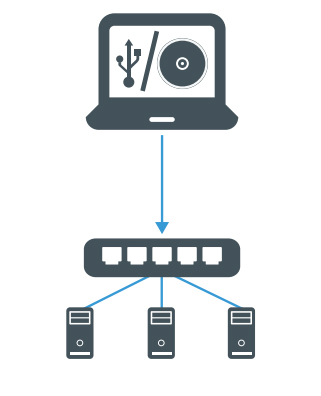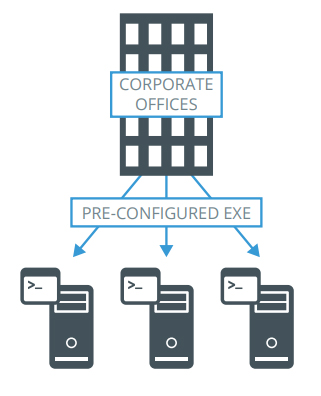When a Windows or Linux system saves a file, it does two things: it creates an entry for the file in the
Master File Table, which functions as a sort of "table of contents" for the drive and saves the file data
itself onto sectors of the hard drive. If a file is deleted using the Recycle Bin, the file is not actually
removed. The file's entry in the Master File Table is deleted, but the data itself still remains intact on the
hard drive. The space that it occupies is marked for use, letting the system know that the space is
available for new files to be written to. Unless new data is written to the space held by the deleted file,
the file still exists on the drive in its original state.
Any number of file-recovery programs can easily look through the drive and find remnants of the file
and put it back together, making it as if it was never deleted in the first place. The only way to truly
delete a file is to overwrite it with other information.
The primary purpose of WipeDrive is to securely overwrite all data to make any type of data recovery
impossible and document the process to comply with all applicable corporate and government
regulations.
UPDATED HARDWARE SUPPORT
WipeDrive now runs in both Linux and WinPE providing the best hardware support. With support for the latest NVMe SSD drives, WipeDrive 9 is ready for the next generation of drives. The world's first secure SSD wipe pattern supports all SSD types regardless of manufacturer. WipeDrive 9 also supports the latest internally mounted M.2 drives.
SECURE REMOVAL OF HPA AND DCO
A host protected area (HPA), sometimes referred to as hidden protected area, is an area of a hard drive
that is not normally visible to an operating system. A Device Configuration Overlay (DCO) is a hidden
area on many of today's Hard Drives (HDDs and SSDs). Usually when information is stored in either the
DCO or HPA, it is not accessible by the BIOS, OS, or the user.
As part of the wipe process, WipeDrive securely removes and overwrites all data contained in HPAs and
DCOs. WipeDrive also purges data when DCO's are locked.
SECURE ERASE OPTION
A modern hard drive comes with many spare sectors. When a sector is found to be bad by the firmware
of a disk controller, the disk controller remaps the logical sector to a different physical sector.
The ANSI T-13 committee which oversees the Advanced Technology Attachment (ATA) interface specification and the ANSI T-10 committee which governs the Small Computer System Interface (SCSI)
specification have incorporated into their standards a command feature known as Secure Erase (SE).
This command completely erases all remapped disk sectors (sectors that the drive no longer uses
because of physical malfunctions).
WipeDrive uses the SE command as part of its NIST 800-88 REV 1 wipe process, to ensure the erasure of
remapped sectors.
DETAILED AUDIT LOGGING
Documenting the secure data destruction process is a requirement for most Government agencies,
companies involved in health care and the financial sector.
WipeDrive creates an audit log documenting every necessary detail to comply with all major regulations
including DoD 5220.22-M, HIPAA, SOX, GDPR, Fiserv and others.
WipeDrive is the only disk-wiping technology that meets NIAP's EAL 2+ Standard. WipeDrive has passed
rigorous tests performed by Common Criteria on IT security and efficacy. WipeDrive recently passed the
National Cyber Security Centre rigorous assessment standards.
LIST OF WIPEDRIVE CERTIFICATIONS
- NIAP EAL 2+
- NCSC (formerly CESG)
- NYCE Certifcation NMX-I-9126/02
- ADISA Certified for SSD
- US DoD 5220.22-M
- NIST 800-88 REV 1 Compliant
- Meets the Common Criteria Evaluation and Validation Scheme
- HIPAA
- FACTA Standards
- Sarbanes-Oxley
- US Army AR380-19
- US Air Force System Security Instruction 5020
- US Navy Staff Office Publication P-5329-26
- US National Computer Security Center TG-025
- NATO NIAPC
- GB HMG Infosec Standard #5 Baseline
- GB HMG Infosec Standard #5 Enhanced
- German VSITR
- Australian Defense Signals Directorate ACSI-33(X0-PD)
- Australian Defense Signals Directorate ACSI-33(X1-P-PD)
- Canadian RCMP TSSIT OPS-II Standard Wipe
- CIS GOST P50739-95
- CSEC ITSG-06
- All drives are wiped in accordance to NIST 800-88 REV 1 specification or any of WipeDrive's supported overwrite patterns. Customers may also create a custom pattern if needed.
- Software is run from a USB drive, CD or EXE Windows Install File.
- Multiple drives can be wiped simultaneously within a single device.
- Full audit-trail compliant with all major data-deletion standards (HIPAA, GDPR, Fiserv, SOX, DoD, GLB, etc.).
CD/USB
Wipe individual computers.

- Program initiated via USB drive or CD.
- Selected storage drives are wiped according to selected or pre-configured settings.
- Audit log generated. Reports can be sent via email, stored on a network, saved to an attached drive or stored in a database.
PXE NETWORK
Many at once at one location.

- Program initiated on a PXE server via USB drive or CD.
- Computers booting into the PXE server automatically start the wiping process according to pre-configured settings. Hundreds of computers can be wiped at once.
- Audit log generated. Reports can be sent via email, stored on a network, saved to an attached drive or stored in a database.
REMOTE WIPE
Many at a time in many locations.

- A pre-configured executable is sent from a centralized IT staff to any computer with administrative access.
- Remote computers start the wiping process without any local interaction.
- Audit log generated. Reports can be sent via email, stored on a network, saved to an attached drive or stored in a database.


